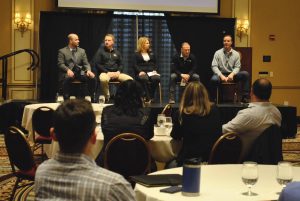RVIA Study IDs Changing RVer Demographics

ELKHART, Ind. – The “typical” RV buyer is getting much younger.
That was the assessment of a panel of RV Industry Association leaders, who gathered Tuesday at Elkhart, Ind.’s Lerner Theatre to share with industry professionals the results of the association’s recent findings on current market conditions and RVers’ paths to purchase.
The 2020 and 2021 study presented data showing RV buyers are trending younger, with 38 percent being Millennials, 31 percent being Gen Xers, 22 percent being Baby Boomers and 9 percent being Gen Zers. The median age for RV buyers is now 33.
“What that tells us is almost 70 percent (of buyers) are Millennials or Gen X,” said Bill Baker, RVIA vice president of membership and research. What’s more, the median age of buyers was found to have dropped over the course of just two years, from a previous median age of 41 years.

RVIA research also shows about two-thirds of RV buyers were married. The average median income for those RV buyers was found to be roughly $90,000.
According to the study, buyers spent an average of $73,115 for their new RV. Millennials averaged about $2,000 more, and 65 percent of them bought new RVs compared to the total average of 57 percent.
Of those buyers, 88 percent purchased an aftermarket part or accessory to enhance their RV, with 56 percent buying three or more aftermarket items, according to the market research.
Meanwhile, some 46 percent of buyers indicated they plan to list their RV on peer-to-peer rental sites.
“That does two things,” Baker explained. “One, it helps them recoup some of the cost, the investment they’ve made in their RV … but the other thing it does is it expands the audience of RVs and opens up it up to even more consumers to try and ultimately bring more buyers.”
Younger buyers, Baker added, tend to buy Class B motorhomes and travel trailers.
“Seventy percent of RVs are travel trailers, so people are buying those,” he said. “But I think younger buyers, those newer buyers, it’s sort of higher-end towables, motorhomes and Type B’s.”
In the study, buyers identified various reasons for buying RVs, including the ability to school their children remotely and to recreate amidst COVID-19 restrictions. Some 31 percent of buyers indicated they would use their RV to take road trips and 30 percent cited the ability to travel in comfort as the top reasons for ultimately deciding to purchase an RV.
“While COVID might have pushed these folks to look at RVing – especially those folks that never would have considered it – the reason that they (RVs) often have been bought is that they want to do the same things that RVers that have done in tradition have done,” Baker said.
The study also questioned how to determine the likelihood of a potential buyer deciding to purchase. One of the biggest indicators is if they’d camped as a child.
“There are a lot of folks that didn’t have that experience and they’re very intimidated by the process,” Baker said.
The second top reason was social media.
“They really look to current owners for that information,” Baker added.
Karen Redfern, chief marketing officer for Go RVing, further discussed this idea. Go RVing changed ad agencies two years ago, she explained, hoping the change would spark new growth in the industry.
“We wanted someone to help us convey energy and vibrancy in RVing,” she said.
Go RVing focused on marketing to high-value audiences. It also focused on two main components: recruiting and retaining. Redfern said that core marketing will target young families and young couples.
“Those are the people that we want to look at RVing in a very different way,” she said. “No matter what you want to do, you can find an RV to help you do it.”
Go RVing hopes to introduce that diversity of products to that audience. Redfern added that Go RVing has 46 brands on record.
“Like anything else, we need to make sure that our image talks to that new generation of buyers,” she said. “A lot of people base what they see of a brand based on what they see in their advertising.”
As a result, Redfern presented the revised Go RVing logo to RVIA members in attendance, explaining the symbolism associated with the open road.
“No matter what people are using their RV for, the one common denominator is you’ve got to get on the road to use it.”
With an emboldened font, bright colors and simplistic design, Redfern hopes will continue to draw attention.
“They will stand out when the consumer sees them, whether they’re scrolling through social media, or whether they see us on the television, or in the marketplace.”
Meanwhile, Redfern said Go RVing’s ads are shorter, bolder, louder and simpler than in previous campaigns to display that energy and vibrancy they hope to share with potential RV buyers.


